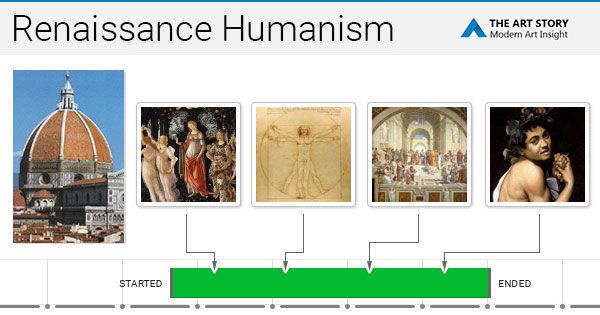Humanism Aspect During the Renaissance Period
The Renaissance was an intense period of economic, political, cultural, and artistic revolution during the Middle Ages. The Renaissance period happened between the 14th and 17th centuries and it played a major part in rediscovering classical art, literature, and philosophy. Many of the greatest artists, thinkers, scientists, authors, and statesmen in history were discovered during this period. The economy was outstandingly improved by new explorations in the efforts of changing the face of Europe. The humanism aspect of the Renaissance period played an essential role in bridging the difference between the present-day civilization and the Middle Ages.
The Middle Ages represents the period between 476 AD during the fall of Rome to the start of the 14th century. The Middle Ages is also known as the Dark Ages and it is acknowledged as a period of famine, war, and pandemic, including the Black Death. A cultural aspect named humanism started in the 14th century and “promoted the idea that man was the center of his own universe, and people should embrace human achievements in education, classical arts, literature, and science” (Albert 250). In this regard, humanism stressed that people need to resolve their problems using both science and reasoning. Therefore, rather than focusing on religious traditions, the approach focused on assisting people to attain personal growth while making the world a greater place.
The Renaissance period began in Florence in Italy where wealthy men played an important role in supporting budding artists. Members of the influential Medici family ruled Florence for over 60 years and were highly acknowledged for backing the humanism movement. According to Albert, “Great Italian writers, artists, politicians and others declared that they were participating in an intellectual and artistic revolution that would be much different from what they experienced during the Dark Ages” (Albert 273). As a result, the movement expanded and reached other Italian states, including Rome, Ferrara, Venice, Bologna, and Milan. Therefore, during the 15th century, ideas of the Renaissance period were being spread to France, Northern, and later Western Europe.
Many famous writers, scientists, intellectuals, and artists in human history came from the Renaissance period. Renaissance geniuses include Leonardo da Vinci, Desiderius Erasmus, Rene Descartes, Galileo, Nicholus Copernicus, Michelangelo, and Sandro Botticelli. Science, architecture, and art were linked approximately during the Renaissance period. According to Khosla, “artists like da Vinci incorporated scientific principles, such as anatomy into their work, so they could recreate the human body with extraordinary precision” (Khosla 59). In this regard, the Renaissance period acknowledges how fields of study were fusing together seamlessly. Architects like Filipo Brunelleschi applied mathematics precisely in engineering immense buildings characterized by expansive domes. Therefore, principles and ideas obtained from different fields of study were applied superbly in creativity and improving the standard of living.
Renaissance arts were characterized by naturalism and authenticity while artists attempted to manifest objects or people in their true-to-life way. The techniques used by Renaissance artists emphasized applying lights, shadows, and perspectives in adding depths to artworks. Some of the most prominent Renaissance works include da Vinci’s The Monalisa and The Last Supper, Michelangelo’s The Creation of Adam and Statue of David, and Botticelli’s The Birth of Venus. While many thinkers were using their talents and abilities to introduce new ideas, other Europeans were focused on learning more regarding their surrounding world. As a result, the explorers discovered new routes for ships connecting the Far East, India, and America. Therefore, the Renaissance period was incredible, blossoming with curiosity, creativity, and beauty.
The Renaissance period was a glorious period that reformed old ideas and brought new perspectives while flourishing the European economy. The explorations and establishment of new colonies helped in generating large income, especially, from gold mines. Developments resulting from banking improvements, expanded trade routes, and advanced manufacturing systems helped tremendously in increasing commercial activities. The Renaissance period laid the foundation for Baroque art which is characterized by more decorative elements, emotional content, and highly complicated compositional devices. According to Hassold, “The difference between Baroque Art and Renaissance is that Baroque art is generally characterized by ornate details whereas Renaissance art is characterized by the fusion of Christianity and science which creates realism through art” (Hassold 3). In this regard, the Baroque arts were designed after the movement of Renaissance in Rome during the 17th century. Therefore, Renaissance humanism was a remarkable intellectual movement in Italy’s 14th and 15th centuries that encouraged people to become curious in the efforts of receiving wisdom.
In conclusion, this paper has argued that Renaissance humanism played a great role in bridging the difference between modern civilization and the Middle Ages. Many prominent writers, scientists, intellectuals, and artists in human history were discovered during the Renaissance period, including Leonardo da Vinci, Michelangelo, and Botticelli. Explorations and new ideas of Renaissance humanism helped remarkably in improving commercial activities and generating large income. Therefore, the humanism aspect of the Renaissance period was a significant intellectual movement in Italy during the 14th and 15th centuries that pushed people to become questioning and interested in gaining and applying wisdom.







